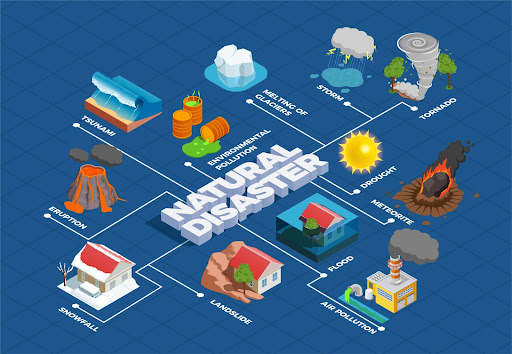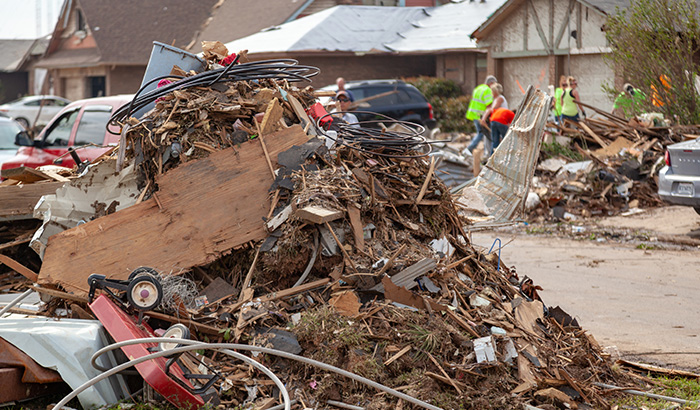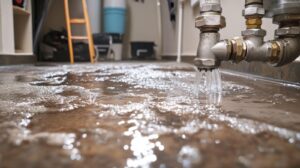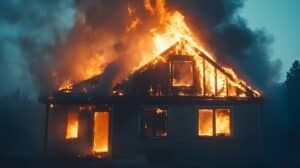Natural disasters can wreak havoc on communities, leaving behind a trail of destruction that requires extensive restoration efforts.
From hurricanes and floods to wildfires and earthquakes, these events can devastate homes, infrastructure, and the environment. In the aftermath, the task of restoring the affected areas can be daunting, requiring careful planning, coordination, and expertise.
Today’s blog covers everything you need to know about natural disaster restoration, including understanding the most common natural disaster types, how restoration works, the steps involved in restoration, and why you should hire a natural disaster restoration company instead of trying to clean up on your own.
Types of Natural Disasters
Common natural disaster types include flooding, hurricanes or cyclones, earthquakes, wildfires, and tornadoes. Here is a brief description of each natural disaster type and what causes them:
- Flooding: Flooding occurs when there is an overflow of water onto normally dry land. It can be caused by heavy rainfall, snowmelt, dam failure, or tsunamis.
- Hurricanes/Cyclones: Hurricanes, also known as cyclones or typhoons, depending on the region, are large tropical cyclonic storms characterized by strong winds and heavy rainfall. They form over warm ocean waters and are fueled by moisture and rising warm air. The collisions of different air masses and pressure differences trigger the formation and intensification of hurricanes.
- Earthquakes: Earthquakes occur when there is a sudden release of energy in the Earth’s crust, resulting in ground shaking. The movement of tectonic plates primarily causes them. When the stress accumulated along fault lines exceeds the strength of the rocks, it leads to rupture and an earthquake.
- Wildfires: Wildfires are uncontrolled fires that rapidly spread across vegetated areas, such as forests or grasslands. Natural factors like lightning strikes or human activities like arson, campfires, or improper disposal of cigarettes can cause them.
- Tornadoes: Tornadoes are violent rotating air columns extending from the base of a thunderstorm cloud to the ground. They form in severe thunderstorms when there is significant wind shear and atmospheric instability.
Understanding the natural disaster types is key to creating emergency preparedness plans to protect your family from future natural disasters.

The Role of Natural Disaster Restoration
Natural disaster restoration is the process of repairing, reconstructing, and restoring the impacted structures and communities in the aftermath of a natural disaster. The primary purpose of natural disaster restoration is to restore normalcy to the lives of those affected by the disaster and enable them to recover from the devastating effects of the disaster.
Prompt and efficient restoration is critical in minimizing the impact of natural disasters on people’s lives, properties, and communities. Natural disasters can cause immense damage to buildings, roads, bridges, and other essential infrastructure, disrupting people’s lives and triggering economic losses.
Timely and effective restoration helps to address these damages quickly, restore order, and reduce the suffering and chaos that disasters can cause.
Additionally, natural disaster restoration plays a significant role in returning an area to its pre-disaster state and improving its resilience to future disasters. Restoration efforts should be designed to fix the immediate damage caused by natural disasters and improve the strength and resilience of the affected structures and communities.
Restoration should incorporate modern engineering and construction techniques to enhance the durability and longevity of infrastructure, making it able to withstand future disasters.
Steps in the Restoration Process
- Initial assessment and planning: The first step in the restoration process is conducting a thorough evaluation of the affected area. This involves evaluating the extent of the damage, identifying necessary repairs, and developing a comprehensive restoration plan. This assessment helps prioritize tasks, allocate resources effectively, and ensure a systematic approach to the restoration process.
- Securing the affected area: After the initial assessment, the next step is to secure the affected area to prevent further damage and ensure safety. This may involve erecting temporary fencing, placing warning signs, or setting up barriers to restrict access to dangerous areas. Securing the area helps protect both restoration workers and the public from potential hazards.
- Removal of debris and hazardous materials: Removing debris and hazardous materials is a critical step in the restoration process. Debris, such as fallen trees, damaged structures, and rubble, must be cleared to create a safe working environment and facilitate further restoration efforts.
Hazardous materials, such as asbestos or chemical spills, must be carefully removed and disposed of following appropriate regulations to mitigate health and environmental risks. - Structural repairs and reconstruction: This step involves repairing or reconstructing the damaged structures and infrastructure. It may include repairing roofs, walls, electrical systems, plumbing, roads, bridges, and other essential components. Restoration teams, including engineers and construction professionals, work to ensure that repairs are done according to safety standards and building codes and that the structures can withstand future disasters.
- Cleaning and sanitization: After the structural repairs are complete, thorough cleaning and sanitization are necessary to remove any residue or contaminants left by the disaster. This includes disinfecting surfaces, removing mold or mildew, and addressing any environmental concerns related to the disaster. Cleaning and sanitization procedures are crucial in creating a safe and healthy living environment for residents and restoring the affected area to its pre-disaster state.
- Restoring utilities and essential services: Restoration efforts also focus on restoring utilities and essential services, such as electricity, water supply, sewage systems, telecommunications, and transportation networks.
This involves repairing or replacing damaged utility infrastructure and ensuring that vital services are fully functional. Restoring utilities and essential services is essential for the smooth recovery of communities and facilitating the return to normalcy for affected residents.
Each step is interconnected and requires coordination among various professionals and organizations involved in the restoration process. The goal is to restore the affected area to its pre-disaster condition, ensuring the community’s safety, well-being, and functionality.

Challenges of Natural Disaster Restoration
Limited resources and manpower: One of the significant challenges in natural disaster restoration is the limited availability of resources and manpower.
During large-scale disasters, there may be a shortage of equipment, building materials, and skilled laborers needed for the restoration process. The demand for resources often exceeds the supply, leading to delays and inefficiencies. Coordinating and mobilizing resources effectively becomes crucial to overcome this challenge in a timely manner.
Environmental and health concerns: Natural disasters can result in environmental and health hazards that complicate the restoration process. For example, floodwaters may carry contaminants, debris may contain hazardous materials, and damaged infrastructure may pose safety risks.
Restoration efforts must address these concerns through proper waste management, decontamination, and ensuring worker safety. Environmental impact assessments and adherence to health and safety protocols play a vital role in overcoming these challenges.
Financial implications and insurance aspects: Restoring the areas affected by natural disasters involves significant financial implications.
The costs associated with repairing and rebuilding infrastructure, providing emergency relief services, and addressing long-term recovery needs can be immense. Public entities, private organizations, and insurance companies often bear these financial burdens.
The availability and adequacy of insurance coverage and the speed and effectiveness of claims processing can impact restoration efforts.
Hiring Professional Restoration Services
Hiring professional restoration services offers several benefits, including:
- Expertise and experience.
- Efficiency and speed.
- Comprehensive restoration solutions.
- Safety and compliance.
- Insurance coordination.
Hiring a professional restoration company takes these burdens off you, allowing you to focus on other important parts of the restoration process.
When hiring a professional restoration company, you’ll want to look for the following qualities:
- Licenses and certifications.
- Reputation and experience.
- Range of services.
- Response time and availability.
- Insurance and documentation support.
- Cost and transparency.
By considering these factors, you can select a reputable and reliable restoration company that meets your specific needs and ensures a successful recovery from a natural disaster.
Call Black Diamond Restoration Today
When it comes to natural disaster restoration, trust the experts at Black Diamond Restoration to be your go-to source. With our years of experience, comprehensive range of services, and commitment to excellence, we are dedicated to helping communities rebuild and recover from the devastating effects of natural disasters.
Discover how our skilled professionals can assist you through every stage of the restoration process. From assessing damages and developing customized plans to executing the work efficiently and safely, we have the expertise and resources to restore your property to its pre-disaster condition.
At Black Diamond Restoration, we understand the urgency and complexity of natural disaster recovery. Our team is available 24/7, ready to respond quickly and effectively to restore normalcy in your life. Let us guide you through the challenges, mitigate environmental and health concerns, and ensure a streamlined insurance process.
Don’t face the daunting task of restoration alone. Choose Black Diamond Restoration as your trusted partner in rebuilding after disaster strikes. Call us today at 801.905.8062 or visit our website to learn more about our services and how we can assist you.
toto slot






